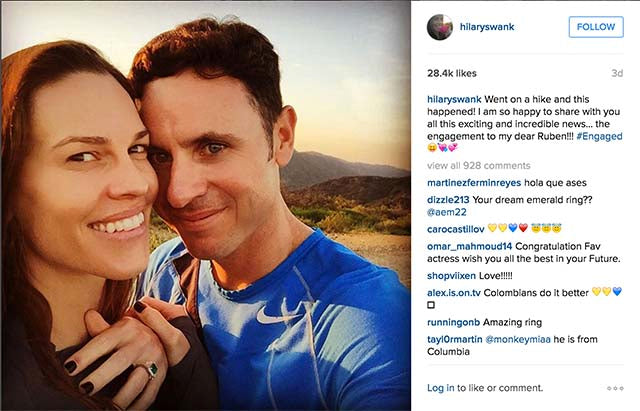
Hilary Swank’s Emerald Engagement Ring
It’s all over the news. Hilary Swank has gotten engaged with a ring that features a green emerald as the center stone. According to a feature in the Chron: “Hilary Swank recently announced her engagement to former tennis pro Ruben Torres, and instead of sporting a sparkly, clear stone, she debuted a vintage-style honker of an emerald.” You’ve got to love that description! “Honker” I wonder if Brian Gavin would let me change “We Do Big Rocks!” to “The Honkers Collection by Brian Gavin?” Probably not.
It goes without saying that Hilary Swank’s vintage style emerald engagement ring looks spectacular. I’ve always been a fan of green emerald, and this one appears to exhibit beautiful, deep hues of green. My only concern is that emerald is much softer than ruby, sapphire, or diamond, and thus it is prone to damage, such as chipping and cracking.
The Mohs Hardness Scale:
On the Mohs Scale of Mineral Hardness, diamond is a 10, and emerald is between 7.5 – 8.0 which means that it is much easier to scratch emerald, than it is to scratch diamond. The purpose of the “Mohs Hardness Scale” is to demonstrate the differences in scratch-ability between different mineral substances. On the Mohs Scale, diamond is a 10, and talc is a 1, making it the softest mineral substance. Rubies and Sapphire which are Corundum score a 9, making them a much better choice than emerald for a colored stone engagement ring.
Common Treatments for Emerald:
Natural emerald is a gemstone which is usually heavily included, much more so than other gemstones, such as diamonds, rubies, or sapphires. In addition, to containing internal inclusions, such as cavities, crystals, and knots, it is common for an emerald to contain internal fractures and fissures. It is also pretty common for natural emerald to contain fractures and fissures which break the surface of the stone.
For this reason, the majority of emeralds are treated in one form or another. This is considered to be standard practice within the trade, however it is also generally agreed upon that such treatments should be disclosed to consumers.
One of the most common treatments for emeralds involves soaking the gem in cedar oil derived from cedar trees, and then placing the emeralds in a heated hydraulic cylinder. The combination of the heat and pressure drives the cedar oil into the emerald, which serves to hide the cracks and fissures. I’ve also seen emeralds treated in similar fashion using a vacuum cylinder. It is also quite common for natural emeralds to be fracture filled, which is also known as being clarity enhanced.
Colored Stone Engagement Rings:
Make no mistake about it, I love green emerald, and I think that Hilary Swank’s emerald engagement ring is absolutely gorgeous! But the jeweler in me experiences a small shudder when the words emerald+engagement+ring are put together in the same sentence. I do much better with diamond+engagement+ring or blue+sapphire+engagement+ring because I know that those options are going to hold-up to daily wear much better than emerald.
Emerald is better suited for rings which are going to be worn occasionally, or in earrings or pendants. It is a softer gemstone which is often heavily included. Note that inclusions within emeralds are referred to as “Jardin” which is pronounced like garden, but with a letter J in the beginning.
















